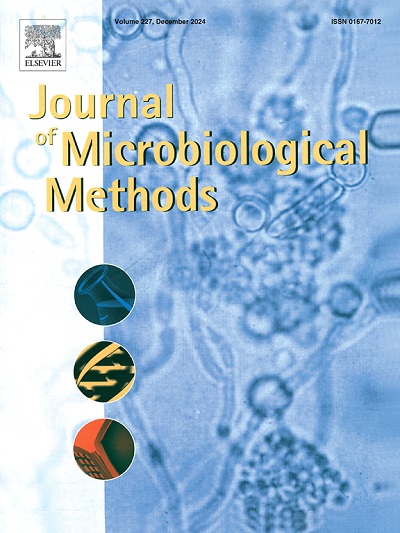Development of a MALDI-TOF MS model for differentiating haemorrhagic septicaemia-causing strains of Pasteurella multocida from other capsular groups
IF 1.9
4区 生物学
Q4 BIOCHEMICAL RESEARCH METHODS
引用次数: 0
Abstract
Pasteurella multocida capsular types A, D, and F cause disease in many animal hosts, including bovine respiratory disease in cattle, which is one of the most globally significant animal diseases. Additionally, P. multocida capsular types B and E cause haemorrhagic septicaemia, a devastating disease primarily of cattle, water buffalo, and bison that develops rapidly with high mortality. Haemorrhagic septicaemia mostly occurs in developing countries and has potential to emerge elsewhere in the world. The diagnosis of haemorrhagic septicaemia currently requires recognition of compatible gross or histologic lesions and serotyping or molecular characterization of strains. In this study, we performed genomic characterization of 84 P. multocida strains, which were then used to develop and validate a matrix assisted laser desorption ionization time-of-flight mass spectrometry (MALDI-TOF MS) biomarker-based method for differentiating non-haemorrhagic septicaemia strains of P. multocida from haemorrhagic septicaemia-causing strains. Haemorrhagic septicaemia strain types B:2,5, E:2,5, and B:3,4 were used to maximize diversity. Three automated classification models were generated and then used to develop an assisted model, which utilized two peaks (6419 and 7729 m/z) to accurately differentiate non-haemorrhagic septicaemia-causing strains from haemorrhagic septicaemia-causing strains of P. multocida. The assisted model performed with 98.2 % accuracy for non-haemorrhagic septicaemia strains, 100 % accuracy for classic B:2,5 and E:2,5 strains, and 84.4 % accuracy for combined haemorrhagic septicaemia-causing strains (B:2,5, E:2,5, and B:3,4) with an overall accuracy of 96.9 %. Our results suggest that MALDI-TOF MS may be used to routinely screen P. multocida isolated from diagnostic cases for initial identification of haemorrhagic septicaemia-causing strains, and to determine whether additional characterizations are warranted.
开发一种 MALDI-TOF MS 模型,用于区分多杀性巴氏杆菌的出血性败血症致病菌株和其他菌囊群。
多杀性巴氏杆菌荚膜 A、D 和 F 型可导致许多动物宿主患病,包括牛呼吸道疾病,这是全球最严重的动物疾病之一。此外,多核荚膜杆菌 B 型和 E 型还会引起出血性败血症,这是一种主要针对牛、水牛和野牛的毁灭性疾病,发病迅速,死亡率高。出血性败血症主要发生在发展中国家,并有可能在世界其他地方出现。出血性败血症的诊断目前需要识别相符合的大体或组织学病变,并对菌株进行血清分型或分子鉴定。在本研究中,我们对 84 株多杀菌素菌株进行了基因组鉴定,然后利用这些菌株开发并验证了一种基于基质辅助激光解吸电离飞行时间质谱(MALDI-TOF MS)的生物标志物方法,用于区分非出血性败血症多杀菌素菌株和导致出血性败血症的菌株。出血性败血症菌株类型为 B:2,5、E:2,5 和 B:3,4,以最大限度地提高多样性。生成了三个自动分类模型,然后用于开发一个辅助模型,该模型利用两个峰(6419 和 7729 m/z)来准确区分非出血性败血症致病菌株和出血性败血症致病菌株。辅助模型对非出血性败血症菌株的准确率为 98.2%,对典型的 B:2,5 和 E:2,5 菌株的准确率为 100%,对合并的出血性败血症致病菌株(B:2,5、E:2,5 和 B:3,4)的准确率为 84.4%,总体准确率为 96.9%。我们的研究结果表明,MALDI-TOF MS 可用于常规筛选从诊断病例中分离出来的多杀菌素,以初步鉴定出血性败血症致病菌株,并确定是否需要进行其他特征鉴定。
本文章由计算机程序翻译,如有差异,请以英文原文为准。
求助全文
约1分钟内获得全文
求助全文
来源期刊

Journal of microbiological methods
生物-生化研究方法
CiteScore
4.30
自引率
4.50%
发文量
151
审稿时长
29 days
期刊介绍:
The Journal of Microbiological Methods publishes scholarly and original articles, notes and review articles. These articles must include novel and/or state-of-the-art methods, or significant improvements to existing methods. Novel and innovative applications of current methods that are validated and useful will also be published. JMM strives for scholarship, innovation and excellence. This demands scientific rigour, the best available methods and technologies, correctly replicated experiments/tests, the inclusion of proper controls, calibrations, and the correct statistical analysis. The presentation of the data must support the interpretation of the method/approach.
All aspects of microbiology are covered, except virology. These include agricultural microbiology, applied and environmental microbiology, bioassays, bioinformatics, biotechnology, biochemical microbiology, clinical microbiology, diagnostics, food monitoring and quality control microbiology, microbial genetics and genomics, geomicrobiology, microbiome methods regardless of habitat, high through-put sequencing methods and analysis, microbial pathogenesis and host responses, metabolomics, metagenomics, metaproteomics, microbial ecology and diversity, microbial physiology, microbial ultra-structure, microscopic and imaging methods, molecular microbiology, mycology, novel mathematical microbiology and modelling, parasitology, plant-microbe interactions, protein markers/profiles, proteomics, pyrosequencing, public health microbiology, radioisotopes applied to microbiology, robotics applied to microbiological methods,rumen microbiology, microbiological methods for space missions and extreme environments, sampling methods and samplers, soil and sediment microbiology, transcriptomics, veterinary microbiology, sero-diagnostics and typing/identification.
 求助内容:
求助内容: 应助结果提醒方式:
应助结果提醒方式:


